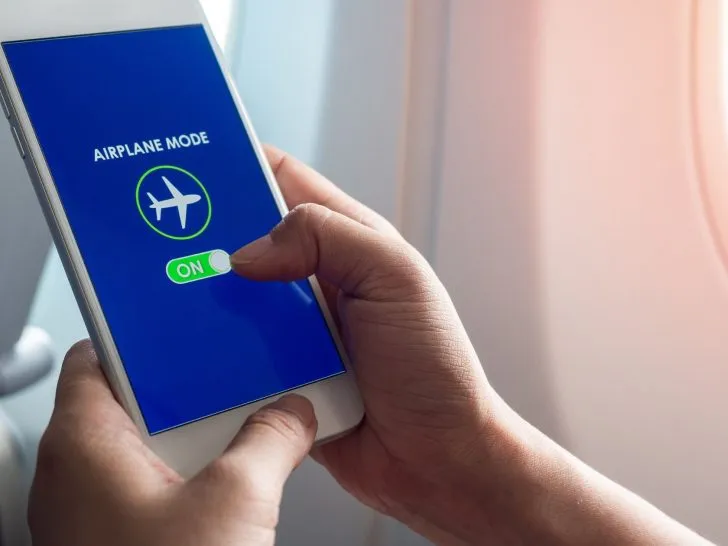Skip to:
- Airplane Mode vs. Turning Off
- Regulations in Aviation
- Electromagnetic Interference
- When Complete Shutdown is Essential
Let’s dive into a topic that’s as intriguing as it is crucial for air travel. “Why do you have to turn your phone off on a plane?” It’s a question that has puzzled many of us as we prepare for takeoff, wanting to know if there is a good reason to keep us disconnected the entire flight.
Also, what about the mysterious ‘airplane mode’ that shuts off cellular connection? As we cruise through this post, we’ll explore the real reason turning off your phone or using airplane mode even matter.
Join me as we journey through the rules laid down by aviation giants like the FAA and the FCC and discover how airborne use interacts with aircraft systems.

Airplane Mode vs. Turning Off
When you’re cruising at 30,000 feet, understanding the difference between putting your phone in airplane mode and turning it off completely is crucial. So, why do you have to turn your phone off on a plane, or is flipping it to airplane mode enough? Let’s break it down.
Airplane Mode
Airplane mode, often termed ‘flight mode’, is a setting on your devices, both for an Android phone or an iPhone. When activated, it cuts off all wireless networks, cellular connections, and radio frequencies, making it compliant with in-flight safety protocols. But it still allows you to use pre-downloaded content or in-flight entertainment.
Bluetooth and In-flight Wi-Fi
While in airplane mode there are two options that can help keep you entertained. You are allowed to re-activate Bluetooth which allows you to connect to Airpods. Also, plenty of airlines offer a limited in-flight wi-fi allowing access to text messages and facebook messenger.
Turning Off or Power Off
Turning off your phone, on the other hand, is like putting it to sleep. It’s more than just disabling access to the nearest cell towers, it’s about ensuring there’s no chance of electromagnetic interference with critical aircraft instruments or navigation equipment. In situations where even minimal risk cannot be entertained, such as bad weather or specific types of aircraft, this is the recommended choice.
Why the Distinction Matters
Understanding this distinction is vital. While flight mode is usually good enough on commercial airlines – allowing you to play games, listen to music, or access offline apps – there are times when flight attendants will instruct passengers to turn off their devices completely. This is not just for compliance with aviation industry standards but for everyone’s safety.
Navigating the Regulatory Skies

Tuning into the Regulations
In the complex airspace of rules and regulations, understanding why you have to turn your phone off on a plane becomes clearer when we look at what governing bodies say. It’s not just about airline policies, it’s a matter of adhering to guidelines set by authorities like the US Federal Communications Commission (FCC) and the Federal Aviation Administration (FAA).
The FCC and FAA Stance
The FCC, responsible for regulating radio communications in the United States, has long expressed concerns about mobile devices. They worry that signals from cellular telephones could interfere with ground networks.
The FAA focuses on potential disruptions to aviation equipment. This dual concern has led to strict guidelines, including the mandate to switch to plane mode or power off during critical phases of flight.
Global Standards and European Perspectives
It’s not just a U.S. thing. The European Union and the European Aviation Safety Agency echo similar sentiments. With the rapid spread of digital technology and mobile networks, these regulatory bodies constantly update their policies, ensuring that passenger safety is paramount.
They all converge on one point, which is the need to minimize interference from personal electronic devices, be it through plane mode or by turning them off.
Why Compliance Matters
So, as we navigate these regulatory skies, remember, the next time cabin crew reminds you to turn off your phone or switch to plane mode, it’s not just about following orders. It’s about ensuring that the navigation systems and critical aircraft instruments on board stay interference-free for a safe journey.

The Tech Behind the Rule
Understanding Electromagnetic Interference (EMI)
At the heart of this discussion is EMI. Our phones emit electromagnetic radiation. This radiation, especially the radio signals from cellular networks, can potentially interfere with critical aircraft instruments like the radio altimeter or navigation equipment.
Cellular Signals and Navigation Systems
Imagine a plane’s navigation systems trying to capture signals from various radio services and navigation aids. Now, introduce the radio waves from a cabin full of mobile devices. This can create a cacophony of signals, leading to possible confusion for the aircraft’s sensitive systems, especially during takeoff and landing when precision is key.
The Role of Airplane Mode
This is where plane mode becomes a hero. By cutting off cellular communication, Wi-Fi, and Bluetooth, plane mode keeps your device operational without the risky radio emissions. But in certain scenarios, like bad weather or sensitive electronic systems on certain aircraft types, even this precaution might not be enough, leading to the need for a complete shutdown.
Why Full Power Off is Sometimes Necessary
In some situations, the potential risk, however minor, is not worth taking. This is why flight attendants may ask you to turn your phone off entirely. It’s about erring on the side of caution, ensuring that the aircraft’s navigation and communication systems function without the slightest interference.

Integrating Safety with Technology
So, as we explore why you have to turn your phone off on a plane, it’s clear that it’s not just a frivolous demand but a well-founded precaution. With concerns about radio signal interference, cellular connections affecting critical aircraft systems, and the need to maintain clear communication with air traffic control, these guidelines are vital. As technology advances, with the rollout of features like in-flight Wi-Fi and changes in cellular service capabilities, these guidelines may evolve. For now, they are an essential part of ensuring a safe and smooth flight experience, adhering to FCC regulations and the directives of the US Federal Aviation Administration.
Frequent Flyer Ambivalence
So many passengers ignore crew members instructions because it seems pointless. They don’t listen to rules about seat belts or window shades or the use of portable electronic devices.
Adherence to these rules as outlined on the FAA website’s safety information page.
Safely Touching Down in the World of In-Flight Phone Usage
Advancements in technology, including the development of aircraft less susceptible to interference from mobile signals and the introduction of in-flight Wi-Fi, point towards a future where the use of mobile phones onboard might see more flexibility. However, the core principle of safety, whether it’s regarding cellular connections, social media usage, or making phone calls, remains unchanged.



Leave a comment